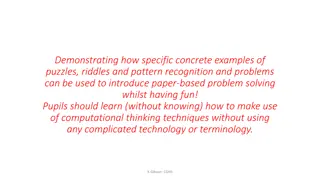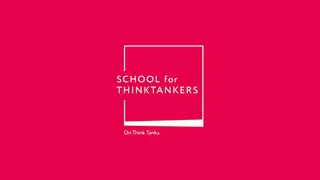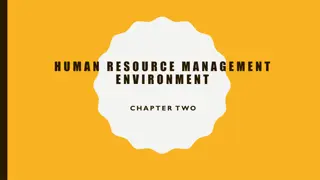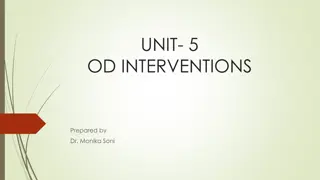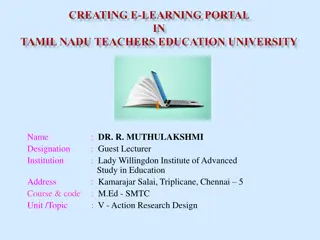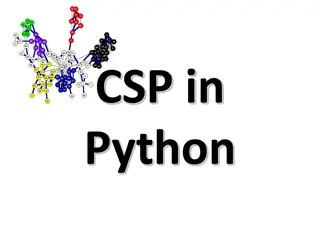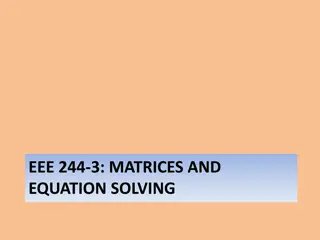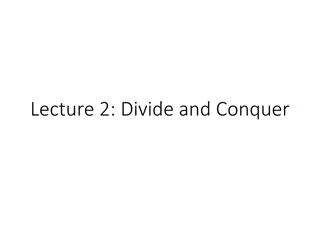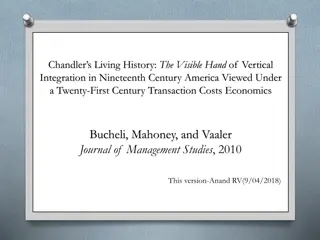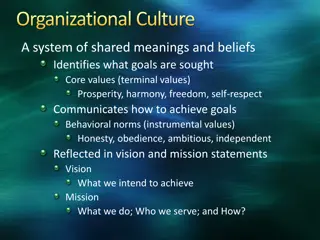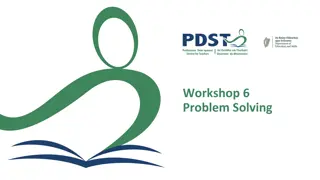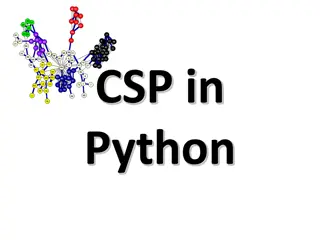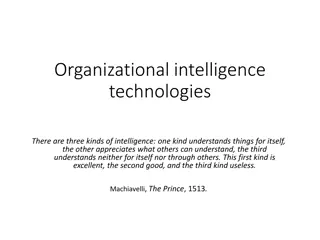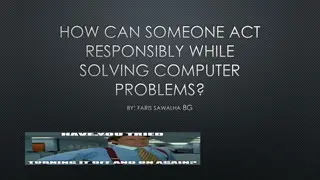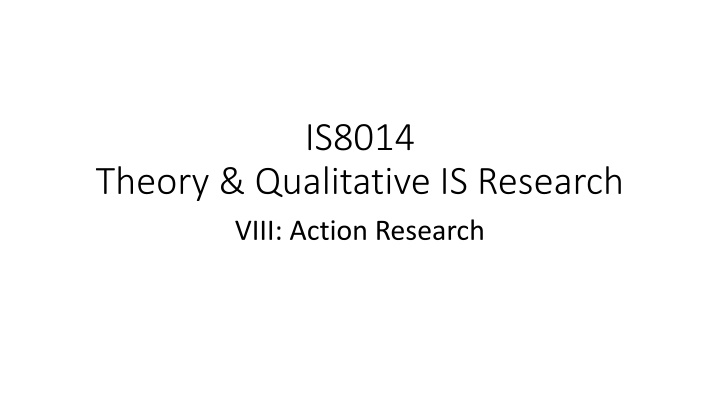
Action Research: Solving Organizational Problems & Improving Practices
Action Research involves researcher intervention to solve organizational problems and improve practices. It contributes to academic theory and organizational practice, addressing client needs and community knowledge. It is rooted in interpretivist epistemology and emphasizes iterative, rigorous, and collaborative approaches. Canonical AR projects investigate organizational change processes in detail, adapting to evolving circumstances. Principles and criteria such as researcher-client agreement, cyclical process model, role of theory, change through action, and specification of learning guide Action Research endeavors.
Download Presentation

Please find below an Image/Link to download the presentation.
The content on the website is provided AS IS for your information and personal use only. It may not be sold, licensed, or shared on other websites without obtaining consent from the author. If you encounter any issues during the download, it is possible that the publisher has removed the file from their server.
You are allowed to download the files provided on this website for personal or commercial use, subject to the condition that they are used lawfully. All files are the property of their respective owners.
The content on the website is provided AS IS for your information and personal use only. It may not be sold, licensed, or shared on other websites without obtaining consent from the author.
E N D
Presentation Transcript
IS8014 Theory & Qualitative IS Research VIII: Action Research
Introduction Action Research involves solving organizational problems improving organizational (employees, managers, customers) by means of researcher intervention, thus contributing to knowledge about both academic theory & organizational practice circumstances for stakeholders 2
Two Demanding Masters Client Need for organizational problem solving Research Community Need for knowledge that is relevant in this organizational situation and is also applicable to other problem contexts (in other organizations) 3
Epistemology Canonical AR is usually premised on an *interpretivist* epistemology The CAR researcher-practitioner needs to engage in many interpretive and diagnostic acts, thinking carefully about the organizational situation, representing the world as experienced by the clients. Disciplined subjectivity and imagination are critical skills 4
Canonical AR is Iterative - with one or more cycles of interventions Rigorous - correct use of methods in the task context Carefully planned iterations to develop detailed problem context knowledge and to identify relevant solutions Continuous problem (re)diagnosis Flexible application of the method Collaborative Researchers and Clients must work together Clients must actively participate in the project 5
Canonical AR Projects A CAR project can be expected to investigate the evolution of an organizational change process in great detail Each organizational context will have a unique set of constraints and idiosyncracies Organizational circumstances are ever changing So you can t plan everything in advance There is an infinite variety of circumstances that you will have to be prepared to adapt to! Can be structured according to principles and criteria, but these need to be applied sensitively 6
Principles & Criteria 1. Researcher-Client Agreement 2. Cyclical Process Model 3. Role of Theory 4. Change through Action 5. Specification of Learning 7
1. Researcher-Client Agreement Guiding foundation for the project Client must understand what CAR involves Mutual guarantees for behaviour Basis for building trust in the organizational context Promote a spirit of shared inquiry 8
RCA Criteria C1a Both the researchers and the client agree that IAR is the appropriate approach for the organisational situation. C1c The client has made an explicit commitment to the project. C1b The researchers and the client jointly specify the focus of the AR project clearly and explicitly. C1e The project objectives and evaluation measures are specified explicitly. C1d The roles and responsibilities of the researchers and client organisation members are specified explicitly. C1f The data collection and analysis methods are specified explicitly. 9
2. Cyclical Process Model Sequential progress through the Cyclical Process Model helps to ensure rigour Some between-stage iteration may occur needs to be justified Usually several cycles are necessary 10
CAR Cyclical Process Model Project Start Project End Diagnosis ActionPlanning Reflection Instrumental Theory Focal Theories Researcher-Client Agreement Evaluation Intervention 11
CPM Criteria C2a The researchers plan to follow the cyclical process model and justify any deviation from it. C2b The researchers will ensure that they have sufficient skills and confidence prior to engaging with the clients in the diagnostic stage. C2c The researchers will immerse themselves into the world of the client prior to and during the project. C2d The researchers will have rich conversations with the clients during the diagnostic stage in order to understand the problem context. C2e The researchers plan to conduct an independent diagnosis of the organisational situation. 12
CPM Criteria C2f The researchers will ensure that they plan their actions explicitly based on the results of their independent diagnosis. C2g The researchers will implement and evaluate the planned actions. C2h The researchers will reflect on the outcomes of the intervention. C2i Following this reflection, the researchers will make an explicit decision on whether or not to proceed through an additional process cycle. C2j Both the exit of the researchers and the conclusion of the project will be due to either the project objectives being met or some other clearly articulated justification. C2k The researchers will consciously adhere to the ethical principle of non- maleficence at all stages of the project. 13
3. Theory Action Research without theory - is not research McKay & Marshall (2001) It is highly unlikely that the researcher can know definitely and in advance the exact theory that will be used or developed Cunningham (1993) Premature application of theory may be counterproductive So theory-free problem diagnosis may need to precede CAR, yet theory is important Two types of theory: instrumental and focal 14
Theory Lewin (1945): There is nothing so practical as a good theory . Ghoshal (2005): Nothing is as dangerous as a bad theory . Both of these two statements apply equally to CAR Selection of an appropriate theory must be handled with great care given the potential for consequences in the organisational setting. 15
Instrumental Theory Particularly valuable for diagnosis and planning Play a mediating role between client and researcher Used to explain and analyse organizational activities/phenomena related to the project/problem Includes any tools, models or processes that theorise how work is done or how outcomes are achieved Our use of the term instrumental theory follows Hambrick s (2007) comment that instrumental theories help us to organize our thoughts, generate coherent explanations [and so] achieve understanding . Such theories will be practical (Lewin 1945) and closely match reality (cf. Weick 1995). 16
Focal Theory Provides the intellectual basis for action-oriented change. May need to be modified as a result of its application in the problem context Is unlikely to remedy an organizational problem alone. Its application must be premised on one or more instrumental theories May need to be changed if it does not fit the project circumstances 17
Theory & Consequences A theory must be selected because it fits the organizational circumstances, the IT, the people, the culture. The client needs to understand the theory and its implications for change before approving it formally. An inappropriate theory could push the organization to change in a direction inconsistent with its organizational culture, leading to internal conflicts, or worse. 18
Theory Criteria C3a The project activities will be guided by a theory or set of theories. C3b The domain of investigation is theoretically relevant to the scholarly interests of the research community. C3c The researchers will select and apply one or more instrumental theories for the independent diagnosis as they seek to derive the causes of the observed problems. C3d The researchers will consider developing conceptual models as a form of instrumental theory to help in the problem diagnosis. C3e The researchers will identify a focal theory during the problem diagnosis. 19
Theory Criteria C3f The researchers and clients will agree on the appropriateness of the instrumental and focal theories for the organisational context and practices. C3g The researchers will consider how combining data from different sources could strengthen both their action-based intervention and their subsequent contribution to knowledge. C3h The planned intervention will be premised on the focal theory and will address the problems diagnosed. C3i The researchers will consider if relationships between the variables from the problem diagnosis and the planned changes could be tested statistically so as to triangulate their findings more rigorously.
Theory Criteria C3j The focal theory will be used to evaluate the outcomes of the intervention. C3k The researchers will evaluate and reflect upon theoretical explanations for the current organisational problem situation. C3l The researchers will reflect on the focal theory used and its ability to predict the change outcomes. C3m The researchers will consider how theory can be inductively developed from the IAR project. 21
4. Change through Action Action and change are indivisible If there is no change No problem, intervention failed, or obstacles prevent successful intervention Both researcher and client must be motivated to design and implement change The change needs to be contextually and culturally appropriate (cf. theory) 22
Change through Action Criteria C4a Both the researcher and client are motivated to improve the situation. C4b The problem and its cause(s) will be specified as a result of the diagnosis. C4c The planned actions will be designed to address the diagnosed cause(s). C4d The researchers will consider how IT artifacts could accompany the planned actions. C4e The client will approve the planned actions before they are implemented. 23
Change through Action Criteria C4f The organisational situation will be assessed comprehensively both before and after the intervention. C4g The researchers will conform with their professional responsibility to ensure that their planned actions are sustainable in the organisational context. C4h The timing and nature of the actions taken will be clearly and comprehensively documented. C4i The researchers will follow up with the client at a suitable time after project completion to assess continued progress.
5. Learning through Reflection Both masters need to learn from the researcher s reflections Practical solutions for the client Knowledge for the broader scholarly community Speceific knowledge for the Action Research community 25
Learning through Reflection Criteria C5a The researcher will provide progress reports to the client and organisational members. C5b Both the researcher and the client will reflect upon the outcomes of the project. C5c The researchers will report their activities and outcomes to the client clearly and comprehensively? C5d The researchers will consider the project results in terms of implications for further action in this situation. C5e The researchers will consider the project results in terms of implications for action to be taken in related research domains. 26
Learning through Reflection Criteria C5f The researchers will reflect on the results in terms of implications for the research community (general knowledge, informing/re- informing theory). C5g The researchers will reflect on the results in terms of the general applicability of IAR. C5h The researchers will consciously reflect on how well their intervention balanced research and action.
6. Ethical Considerations for Action Research Avison et al. (1999, p.94), observed that action research combines theory and practice (and researchers and practitioners) through change and reflection in an immediate problematic situation within a mutually acceptable ethical framework . McKay and Marshall (2001, p.55) also emphasise that the researcher is ethically bound to try to alleviate the problem . Shah et al. (2007a, p.764) note that they drew up a formal research agreement to define the ethical guidelines yet provide no details about its content Myers and Venable (2014, p.802) suggest that there is a need to initiate a dialog and debate about the need for ethical principles .
Ethics and Stakeholders Apart from the action researchers, AR involves clients These may be managers, employees, customers, supply chain partners, third party service providers, etc. Arguably, each has a more-or-less participative role to play AR is often premised on collaborative acts between researcher and client the researcher and client work together in planning and implementing change in order to ameliorate a problem situation, and thereby improve circumstances for a variety of stakeholders But here s the rub: getting them to participate is far from simple Also, the researcher has to get prepared in order to participate effectively
Ethical Perspectives Chatterjee and Sarker (2014) identify consequentialism, deontology and virtue as three major ethical perspectives. Consequentialist ethics usually focus on the generation of positive outcomes for the stakeholders whose interests are central to the topic of enquiry. Deontological ethics are associated with duties. These often involve respecting the rights of individuals, so long as the rights of others are not impinged upon. Virtue ethics relate to the character of the individual actor and the assertion that good people (or institutions) will do good things. For instance, Kohli and Kettinger (2004) suggest that patience and flexibility are two of the desired virtues for action researchers, 30
Ethical Dilemmas (after Rapoport, 1970) Role dilemma action researchers play two roles: researcher and consultant, and thus serve two masters What promises should the action researcher make, given the need to improve organizational circumstances and achieve research objectives? Value dilemma the differences in values between researchers and clients Clients likely want quick and decisive action, but researchers tend to work more slowly, methodically in the pursuit of knowledge Goal dilemma the difference between the practical problem and the research problem The interests of the client and researcher are not perfectly aligned
For Instance, Mumford (2001, p. 15) reported how she was always able to avoid working on projects where she disagreed with the ethics of the organization. For instance, she always refused to work on projects which would involve employee redundancy , reflecting a deontological stance. Researchers with a more critical interest may have an emancipatory goal for employees, aiming to ameliorate circumstances for them. 32
Ethics, and Theoretical Contributions A consequentialist view would be that the researcher has an ethical obligation to create a positive outcome for the organisation, only suggesting actions that improve the problem situation (Baskerville and Wood-Harper, 1996, 1998), even though this may constrain the researcher from reaching theoretically interesting conclusions. Both Lewin (1945) and Ghoshal (1996) observed that theories must be appropriate for the organizational context. Scholars who venture into the organizational arena with theory-in-hand beware! If, by dint of your academic enthusiasm, you neglect the interests of the organization and foist on them a damaging process or solution based on a theory that is of intellectual interest to you, then watch out. In more litigious societies, professional indemnity insurance may be advisable. 33
Ethics and Participation in AR The ethics of collaboration Researchers and clients work together collaboratively The ethics of competence researchers must be knowledgeable about the context, the industry, the nature of work in the client s world and then engage in meaningful conversations with clients as they diagnose problems and plan interventions The ethics of persistence It can take years to complete an AR project The ethics of consent and anonymity Protecting identities and the right to opt out 34
The Principle of Ethical Participation C6a Researchers will consciously consider involving client team members throughout all the stages of the project. C6b Researchers will ensure that clients (especially the project champion) are aware of the academic dimension of the project. C6c Both researchers and clients are responsible for communicating changes in circumstances that materially influence the project. C6d Researchers will accept the client s prerogative to attend to pressing needs that may interrupt a project. C6e Researchers will seek to develop competence in both AR as a method and the context of the client before they start the diagnosis. 35
The Principle of Ethical Participation C6f Researchers will undertake to report how they developed competence central to the domain of investigation in the formal write up of the project. C6g Researchers will persevere with a project until its completion or termination. C6h Researchers will ensure that all those involved in a project are informed about its objectives. C6i Researchers will ensure that all interactions with client team members are protected by a guarantee of anonymity (pseudonymity), unless an individual person explicitly affirms that such anonymity (pseudonymity) is not necessary. C6j Researchers will ensure that all client team members provide affirmative consent to participate in an AR project. 36
Illustrating the CAR Process From 2014-2016, I worked with Louie Wong, my PhD student, on an extended study of knowledge sharing in Velox, a global logistics firm I will draw on this experience to demonstrate the impact of CAR in practice in the next group of slides Knowledge Sharing in a Global Logistics Provider: An Action Research Project 37
Introduction Knowledge sharing is important for firms in today s competitive business environment Some resource-rich firms provide abundant IS-based work systems to their employees Our focus is the global logistics sector DHL, Fedex, UPS, TNT, SF Express, etc. 38
Velox We have been working with Velox, a global courier and delivery services firm, and in particular the operations in Guangzhou Velox deals with a variety of stakeholders: Internal: Sales/Post-Sales, Delivery, Customs Clearance External: Customers, Customs & Excise 39
The Nature of Work While some work is standardised, Velox operates in an environment characterised by a frequently changing legal infrastructure, as well as intense competition with other logistics firms, both local and global As a result, knowledge about procedures and best practices must be both updated regularly and disseminated to all who need to know 40
Entrance The Greater China HR Managing Director introduced us to the China Operations Team and an Exec-VP for China Mutual interest on knowledge sharing consulting collaboration as Velox is looking for a solution to address customs clearance knowledge proficiency Based on over 1100 customers comments, knowledge issues among employees which they termed as knowledge dimension was identified as one of the key areas for improvement in Velox s customs clearance operations This led to our proposing an action research investigation that would seek to uncover the key barriers to effective knowledge sharing as well as work with Velox on overcoming those barriers 41
Initial Meetings & Proposal Explain the consulting approach Establish mutual understanding for on-going commitments time and resources implementation of changes in the organisation formal agreement to allow the consultant to gain access to employees and relevant corporate internal information Prepared proposal, which detailed Objectives Scope Consulting Approach Estimated budget 42
Problems to be Solved / Research Questions How is knowledge shared by the employees of Velox as they create knowledge-centric services and solutions for their customers? How can effective knowledge sharing among employees be enabled and sustained in order to provide quality and consistent services to customers? 43
The Collaborating Team Pseudonym Title Role Regional Vice President, China Albert Project Sponsor Managing Director of Human Resources (China) Belle Matchmaker & Original project sponsor. MD of HR (AP) Managing Director, Operations, Northern & Southern China Chris Regional business leader, reports to Albert Senior Manager, Operations, China Debby Client side PL, reports to Albert Senior Manager, HR, China Elaine Project team member Senior Manager, OPs, GZ, China Flora Project team member Manager, Marketing, AP HQ George Project team member Manager, OPs, GZ, China Harold Project team member 44
Research Approach Action Research Iterative, rigorous and collaborative Focuses on both organizational development and the generation of knowledge We reached agreement with Velox before starting: Action research is appropriate The focus and objectives of the project Client commitment Roles and responsibilities Procedures Consent to participate and confidentiality 45
Initial Work Greater China HR Managing Director who introduced us to the China Operations Team and a VP for China Mutual interest on knowledge sharing research collaboration as Velox is looking for a solution to address customs clearance knowledge proficiency This led to our proposing an action research investigation that would seek to uncover the key barriers to effective knowledge sharing as well as work with Velox on overcoming those barriers 46
Timelines 47
Seminars and Interviews In the first action cycle, we offered an introductory seminar to 60 managers where we highlighted key issues connected with knowledge sharing and its benefits, as well as the role of technology in knowledge sharing Our diagnosis took the form of multiple interviews with employees at different levels and in different locations In all these interviews, we sought to identify Features of the operating environment that affected knowledge sharing The types of knowledge involved and the way it could be represented Attitudes towards knowledge sharing among employees Resources available to stimulate, encourage, reward or facilitate knowledge sharing The technology available for sharing The technology not available yet preferred for sharing We validated the interview findings and our analysis through communication meetings with Velox s front-line employees 48
Instrumental Theory We used Work System Theory (WST) (Alter, 2013) as an instrumental theory to summarise our findings and guide our analysis WST provides a common language to enable conversations among the researchers and stakeholders at different levels of the collaborating firm Key to demonstrate researcher s understanding of the current situation Facilitate trust building 49
WST Analysis 1 Key Problem: Customers perceive call agents lack knowledge on customs clearance process Who are the Customers of the System? Customers who have shipments with insufficient data for customs clearance Customer service representatives at the call centre (CSR) Account Executives (AE) Products and Services in the Work System Notification of customs clearance issues Explanation of customs clearance issues Request additional information/documents Customs clearance status update 50


